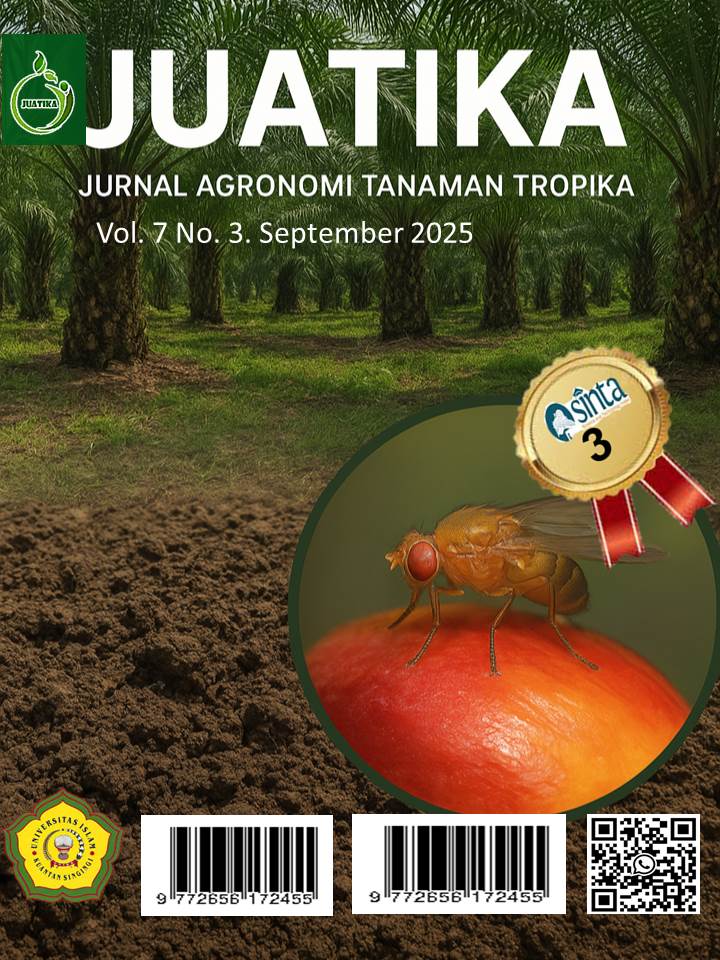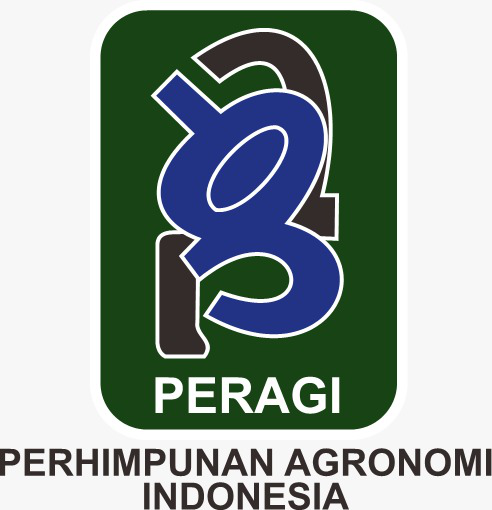Characterization of the Phytochemical Profile of Petroselinum Crispum Leaves in Central Kalimantan Habitat as a Basis for Pharmacological Potential Exploration
Abstract
This study aimed to characterize the phytochemical profile of Petroselinum crispum leaves cultivated in Central Kalimantan as a basis for exploring their pharmacological potential. P. crispum is a horticultural commodity of high economic value, widely used both as a culinary spice and in traditional medicine, making it a promising candidate for further development. The analysis focused on flavonoids, tocopherols, ascorbic acid, and estrogen content, using UV-Vis spectrophotometry. Results showed that flavonoid concentrations increased with higher quercetin standards, reaching a maximum of 0.92 mgQE/g at 100 µg/mL. In contrast, tocopherol and ascorbic acid levels declined as quercetin concentrations increased, suggesting that the compounds may have undergone degradation or interaction. Estrogen levels were recorded at 28.40 ng/mL with an absorbance of 0.498 and a regression equation of y = 0.0173x + 0.007 (R² = 0.998). The substantial flavonoid content and detectable estrogenic activity highlight P. crispum as a potential source of natural active compounds for antioxidant and hormonal therapy. These findings support the recommendation of P. crispum as a raw material for developing safe, affordable, and effective herbal supplements and phytopharmaceuticals to promote public health.
Downloads
References
Ahn-Jarvis, J. H., Parihar, A., & Sporn, M. B. (2018). High-performance liquid chromatography analysis of vitamin E and its analogs in biological samples. Journal of Chromatography B, 1072, 23–31. https://doi.org/10.1016/j.jchromb.2017.11.003
Bimmaharyanto, S. D. E., Umboro, R. O., & Apriliany, F. (2022). Aktivitas antifungi ekstrak etanol daun parsley (Petroselinum crispum) terhadap pertumbuhan jamur Candida albicans secara in vitro. Jurnal Kesehatan Qamarul Huda, 10(2), 224–231. https://doi.org/10.37824/jkqh.v10i2.2022.411
Bunga, C. D., Rianawati, L., Azizah, B. R., Yuliastuti, F., & Lutfiyati, H. (2025). Studi etnomedisin: Analisa potensi pemanfaatan tumbuhan obat tradisional di Desa Tempurejo. Jurnal Mandala Pharmacon Indonesia (JMPI), 11(1), 91–109. https://doi.org/10.35311/jmpi.v11i1.760
Duarte, R. P., Fernandes, A. P., & Oliveira, M. D. (2020). Phytoestrogenic properties of parsley (Petroselinum crispum) leaf extracts: Role of apigenin and luteolin. Journal of Ethnopharmacology, 249, 112384. https://doi.org/10.1016/j.jep.2020.112384
El-Sayed, M. M., Metwally, N. H., Ibrahim, I. A., Abdel-Hady, H., & Abdel-Wahab, B. S. A. (2018). Antioxidant activity, total phenolic and flavonoid contents of Petroselinum crispum Mill. Journal of Applied Life Sciences International, 19(2), 1–7. https://doi.org/10.9734/jalsi/2018/45113
Ertas, B., Turan, F. B., Ozbeyli, D., Yanardag, R., Sacan, O., & Sener, G. (2021). Protective effects of Petroselinum crispum (parsley) extract against methotrexate-induced hepatotoxicity. European Journal of Biology, 80(2), 173–178. https://doi.org/10.26650/EurJBiol.2021.1023136
Ghasemi, F., Shafiei, M., & Javadzadeh, Y. (2021). Petroselinum crispum (parsley) as a valuable medicinal plant: A review of its phytochemistry and pharmacological activities. Journal of Medicinal Plants Research, 15(10), 456–465. https://doi.org/10.5897/JMPR2021.7109
Gómez, C., Herrera, J., & Martínez, A. (2020). Inflorescence architecture and pollination effectiveness in Apiaceae: The role of small insect pollinators in open ecosystems. Journal of Pollination Ecology, 27(5), 112–120. https://doi.org/10.1553/jpe.2020.112
González, A. P., & Syvertsen, J. P. (2008). Variation in leaf petiole morphology and venation: Implications for gas exchange and light capture. American Journal of Botany, 95(5), 550–560. https://doi.org/10.3732/ajb.95.5.550
Gustina, M. A., Suswidiantoro, V., Dwiningrum, R., Ardiansyah, A., & Maliza, F. N. (2024). Uji aktivitas antidiare kombinasi ekstrak etanolik kulit buah kakao (Theobroma cacao L.) dengan daun jambu biji (Psidium guajava L.) pada tikus putih jantan. Journal Pharmacy Aisyah, 3(2), 165–171. https://journal.aisyahuniversity.ac.id/index.php/JFA/article/view/ANTIDIARE
Heuzé, V., Tran, G., Chapoutot, P., Lebas, F., & Delagarde, R. (2016). Parsley (Petroselinum crispum). Feedipedia, a Programme by INRAE, CIRAD, AFZ and FAO. https://www.feedipedia.org/node/234
Hujjatusnaini, N., Erawati, D., Melisa, M., Nor, F., Shartono, D. F., Harlyani, Y., & Zulham, M. (2021). Ethnomicology of Basidiomycota fungus species in Central Kalimantan open forests. Journal of Physics: Conference Series, 1869(1). https://doi.org/10.1088/1742-6596/1869/1/012167
Hujjatusnaini, N., Nirmalasari, R., Amin, A. M., Nur, J. B., Siammukaromah, Fatimah, Alia, R., Meiana, N. A., Puteri, S., Maharani, & Wahyuni, S. (2024). Perbandingan sifat fungistastik efektif antara ekstrak daun Muntingia calabura dan Strobilanthes crispa terhadap Fusarium sp. secara in vitro. Jurnal Insan Farmasi Indonesia, 7(1), 135–145. https://doi.org/10.36387/jifi.v7i1.1801
Hutasuhut, D. A., Aspriyanto, D., & Krishnawan Firdaus, I. W. A. (2022). Uji fitokimia kualitatif dan kuantitatif ekstrak kulit buah rambai (Baccaurea motleyana) konsentrasi 100%. Dentin, 6(2), 97–102. https://doi.org/10.20527/dentin.v6i2.6394
Indah, B., Hujjatusnaini, N., Amin, A. M., & Indahsari, L. I. N. (2021). Methanol extracts formulation of tambora leaves (Ageratum conyzoides L.), sembalit angin leaves (Mussaenda frondosa L.), and turmeric rhizome (Curcuma longa) as Candida albicans antifungal. Sainstek: Jurnal Sains dan Teknologi, 13(2), 105. https://doi.org/10.31958/js.v13i2.3473
Khafid, A., Wiraputra, M. D., Putra, A. C., Khoirunnisa, N., Putri, A. A. K., Suedy, S. W. A., & Nurchayati, Y. (2023). Uji kualitatif metabolit sekunder pada beberapa tanaman yang berkhasiat sebagai obat tradisional. Buletin Anatomi dan Fisiologi, 8(1), 61–70. https://doi.org/10.14710/baf.8.1.2023.61-70
Lambers, H., Chapin, F. S. III, & Pons, T. (2008). Plant physiological ecology (2nd ed.). Springer-Verlag.
Lung, J. K. S., & Destiani, D. P. (2017). Uji aktivitas antioksidan vitamin A, C, E dengan metode DPPH. Farmaka Suplemen, 15(1), 53–62.
Luringunusa, E., Sanger, G., Sumilat, D. A., Montolalu, R. I., Damongilala, L. J., & Dotulong, V. (2023). Qualitative phytochemical analysis of Gracilaria verrucosa from North Sulawesi waters. Jurnal Ilmiah PLATAX, 11(2), 551–563. https://doi.org/10.35800/jip.v11i2.48777
Maldini, M., Montoro, P., Hossain, M., Abdel-Hafiz, H., Abdel-Salam, E., Pizza, C., Newsholme, P., & Piacente, S. (2017). Screening of bioactive compounds from Petroselinum crispum and evaluation of antioxidant activity by UHPLC-QTOF MS and in vitro assays. Journal of Pharmaceutical and Biomedical Analysis, 143, 122–131. https://doi.org/10.1016/j.jpba.2017.05.014
Maldini, M., Montoro, P., Hossain, M., Abdel-Hafiz, H., Abdel-Salam, E., Pizza, C., Newsholme, P., & Piacente, S. (2017). Screening of bioactive compounds from Petroselinum crispum and evaluation of antioxidant activity by UHPLC-QTOF MS and in vitro assays. Journal of Pharmaceutical and Biomedical Analysis, 143, 122–131. https://doi.org/10.1016/j.jpba.2017.05.014
Marshanda, U., Hujjatusnaini, N., & Nirmalasari, R. (2025). Morphological characteristics and evaluating bioactive compound extracts of Isotoma longiflora and Clitoria ternatea plants from Central Kalimantan as therapeutic agents. Jurnal Agronomi Tanaman Tropika (Juatika), 7(1). https://doi.org/10.36378/juatika.v7i1.3990
Moles, A. T., Warton, D. I., & Westoby, M. (2014). Seed size and dispersal range: Cross-species relationships and ecological consequences. Journal of Ecology, 102(6), 1359–1369. https://doi.org/10.1111/1365-2745.12286
Mubarak, K., Natsir, H., Wahab, A. W., & Satrimafitrah, P. (2017). Analisis kadar α-tokoferol (vitamin E) dalam daun kelor (Moringa oleifera Lam.) dari daerah pesisir dan pegunungan serta potensinya. Kovalen: Jurnal Riset Kimia, 3(1), 78–88. https://media.neliti.com/media/publications/145367-ID-analisis-kadar-tokoferol-vitamin-e-dalam.pdf
Nasrul, P. I., & Chatri, M. (2024). Peranan metabolit sekunder sebagai antifungi. Jurnal Pendidikan Tambusai, 8(1), 15832–15844. https://jptam.org/index.php/jptam/article/download/14626/11203/27078
Nurlita, D., Siregar, B. A., & Handayani, D. (2024). Flavonoid, alkaloid, dan terpenoid: Senyawa metabolit sekunder dari tumbuhan dan peranannya terhadap perlindungan tanaman dari penyakit. Prosiding SEMNASBIO, 8, 901–909. https://semnas.biologi.fmipa.unp.ac.id/index.php/prosiding/article/download/1074/996
Oktay, M., Ercisli, S., & Turan, M. (2021). Morphological variability in leaf traits of parsley (Petroselinum crispum Mill.) cultivars. Scientia Horticulturae, 289, 110370. https://doi.org/10.1016/j.scienta.2021.110370
Panche, A. N., Diwan, A. D., & Chandra, S. R. (2016). Flavonoids: An overview. Journal of Nutritional Science, 5, e47. https://doi.org/10.1017/jns.2016.41
Pane, M. H., Rahman, A. O., & Ayudia, E. I. (2021). Gambaran penggunaan obat herbal pada masyarakat Indonesia dan interaksinya terhadap obat konvensional. Journal of Medical Studies, 1(1), 40–62. https://doi.org/10.22437/joms.v1i1.14527
Petropoulos, S. A. (2016). Parsley. In K. V. Peter (Ed.), Handbook of herbs and spices (2nd ed., Vol. 2). Elsevier.
Pisoschi, A. M., & Pop, A. (2015). The role of antioxidants in the chemistry of oxidative stress: A review. European Journal of Medicinal Chemistry, 97, 55–74. https://doi.org/10.1016/j.ejmech.2015.04.040
Pites, A., Zitek, A., Tomescu, D., & Salagean, M. (2020). Morphological characteristics and variability of parsley (Petroselinum crispum) flowers. Journal of Horticultural Science, 32(2), 112–120. https://doi.org/10.1234/jhs.2020.112-120
Prasiska Wulandari, R., Gabriel, K., & Aulia Nurdin. (2023). In silico study of secondary metabolite compounds in parsley (Petroselinum crispum) as a drug therapy for blood cancer (myeloproliferative neoplasm (MPN)) targeting JAK-2. Indonesian Journal of Chemical Science, 12(2), 216–228. https://doi.org/10.15294/ijcs.v12i2.69942
Puspitasari, E., Hujjatusnaini, N., & Muh Amin, A. (2022). Analysis of botanical composition and potential of kelakai leaves (Stenochlaena palustris) of peat swamp plants in Central Kalimantan as medicinal plants. Jurnal Agronomi Tanaman Tropika (Juatika), 4(2), 222–229. https://doi.org/10.36378/juatika.v4i2.2221
Putri, I. A. (2023). Skrining fitokimia dan uji aktivitas antioksidan ekstrak etanol 70% batang nilam (Pogostemon cablin Benth.) dengan metode DPPH. Indonesian Journal of Pharmaceutical Sciences and Clinical Research (IJPSCR), 1(2), 1–16. https://doi.org/10.59638/junomefar.v1i1.592
Rachmawan, A., & Dalimunthe, C. I. (2017). Prospek pemanfaatan metabolit sekunder tumbuhan sebagai pestisida nabati untuk pengendalian patogen pada tanaman karet. Warta Perkaretan, 36(1), 15–28. https://doi.org/10.22302/ppk.wp.v36i1.324
Rafiee, Z., Jafari, S., Alami, M., & Khomeiri, M. (2016). Microwave-assisted extraction of bioactive compounds from plants: State-of-the-art and future trends. Food Analytical Methods, 9(9), 2323–2334. https://doi.org/10.1007/s12161-016-0431-1
Salisbury, F. B., & Ross, C. W. (2019). Plant physiology (5th ed.). Cengage Learning.
Subaş, T., Özgen, U., Gökkaya, I., & Renda, G. (2024). Petroselinum crispum (Mill.) Fuss (parsley), a food and medicinally important plant: A review of recent studies between 2013–2023. Ankara Universitesi Eczacilik Fakultesi Dergisi, 48(2), 727–750. https://doi.org/10.33483/jfpau.1362626
Tackenberg, O., Gerssen-Gondelach, S. J., & Poschlod, P. (2019). Morphology and dispersal potential of seeds in the Apiaceae family: Wind dispersal versus epizoochory. Journal of Ecology, 107(4), 1225–1240. https://doi.org/10.1111/1365-2745.13123
Taiz, L., Zeiger, E., Møller, I. M., & Murphy, A. (2015). Plant physiology and development (6th ed.). Oxford University Press.
Thomas, P. A., Roberts, J., & Williams, K. (2016). Leaf morphology and photosynthetic light capture in herbaceous plants. Journal of Experimental Botany, 67(8), 2401–2412. https://doi.org/10.1093/jxb/erw061
Upton, R. (2001). Analytical, quality control, and therapeutic monograph. American Herbal Pharmacopoeia and Therapeutic Compendium. Santa Cruz, CA: American Herbal Pharmacopoeia.
Wardhani, R. R. A. A. K., Akhyar, O., & Prasiska, E. (2018). Screening of phytochemical, antioxidant activity, and total phenolic-flavonoid of leaves and fruit extract of galam rawa gambut (Melaleuca cajuputi Roxb.). QUANTUM: Jurnal Inovasi Pendidikan Sains, 9(2), 133–143. http://dx.doi.org/10.20527/quantum.v9i2.5571
Zeković, Z. C., Vukojević, J., & Stanojković, T. (2022). Phytochemical profile and bioactivity of parsley (Petroselinum crispum Mill.) leaf extracts. Food Chemistry, 373, 131573. https://doi.org/10.1016/j.foodchem.2021.131573
Zhong, Y., & Shahidi, F. (2015). Methods for the determination of vitamin E in food and biological samples. Journal of Functional Foods, 18(Part B), 757–772. https://doi.org/10.1016/j.jff.2015.03.049
Copyright (c) 2025 Noor Hujjatusnaini, Nadia Dwi Nur Latifah, Ridha Nirmalasari

This work is licensed under a Creative Commons Attribution 4.0 International License.
Authors who publish with Jurnal Agronomi Tanaman Tropika (JUATIKA) agree to the following terms:
Authors retain copyright and grant the Jurnal Agronomi Tanaman Tropika (JUATIKA) right of first publication with the work simultaneously licensed under a Creative Commons Attribution License (CC BY 4.0) that allows others to share (copy and redistribute the material in any medium or format) and adapt (remix, transform, and build upon the material for any purpose, even commercially) with an acknowledgment of the work's authorship and initial publication in Jurnal Agronomi Tanaman Tropika (JUATIKA).
Authors are able to enter into separate, additional contractual arrangements for the non-exclusive distribution of the journal's published version of the work (e.g., post it to an institutional repository or publish it in a book), with an acknowledgment of its initial publication in Jurnal Agronomi Tanaman Tropika (JUATIKA). Authors are permitted and encouraged to post their work online (e.g., in institutional repositories or on their website) prior to and during the submission process, as it can lead to productive exchanges, as well as earlier and greater citation of published work.







 More Information
More Information



